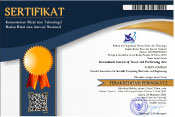*corresponding author
AbstractThis article discusses campursari’s music, which has an increasingly broad role, from profane to sacrilegious Islamic areas. Since its birth, this music serves as entertainment music. In the era of the 1990s and its peak in the 2000s, this music entered and interacted with the Islamic community. The entry of campursari music into the Islamic religious community is the embodiment of expectations and demands for environmental situations and conditions. Hopes and needs give birth to musical syncretism, which gives birth to adaptation strategies. Verstehen are appropriate methods for recognizing forms of adaptation and syncretism. The choice of the verstehen method is because this article does not merely highlight the problem of music, but also tries to understand the social actions of campursari musicians in serving the muslim community via campursari music. The choice of this approach is because musical adaptation stems from the idea that the birth of musicality has the support of a socially developed network of meanings. The benefit is to recognize the principles and rules of adaptive value and productive syncretism that occur behind music phenomena. The results of this study indicate that campursari's performance is sufficient to prove that campursari's musical musicality in the context of Islamic rituals is productive syncretism. Adaptation and syncretism are thus two methods and ways of building products, both of which must co-exist.
KeywordsMusic Syncretism; Ritual Event; Religious; Campursari; Adaptation
|
DOIhttps://doi.org/10.31763/viperarts.v2i1.130 |
Article metrics10.31763/viperarts.v2i1.130 Abstract views : 2777 | PDF views : 1173 |
Cite |
Full Text Download Download
|
References
J. Wallach and E. Clinton, “History, Modernity, and Music Genre in Indonesia: Popular Music Genres in the Dutch East Indies and Following Independence,†Asian Music, vol. 44, no. 2, pp. 3–23, 2013, DOI: 10.1353/amu.2013.0020.
P. Yampolsky, “Three Genres of Indonesian Popular Music: Genre, Hybridity, and Globalization, 1960-2012,†Asian Music, vol. 44, no. 2, pp. 24–80, 2013, DOI: 10.1353/amu.2013.0018.
Skelchy, “Voice, Age, and Islamic Practice in the Life of the Indonesian Keroncong Vocalist Waldjinah,†Ethnomusicology, vol. 63, no. 3, p. 445, 2019, DOI: 10.5406/ethnomusicology.63.3.0445.
M. Perlman, “The Traditional Javanese Performing Arts in the Twilight of the New Order: Two Letters from Solo,†Indonesia, vol. 68, p. 1, Oct. 1999, DOI: 10.2307/3351295.
P. Yampolsky, “Javanese Gamelan and the West by Sumarsam,†Asian Music, vol. 49, no. 2, pp. 158–162, 2018, doi: 10.1353/amu.2018.0019.
M. Rudiana, “Sundanese Karawitan and Modernity,†Panggung, vol. 27, no. 3, Nov. 2017, doi: 10.26742/panggung.v27i3.278.
N. I. Cooper, “Retuning Javanese Identities: The Ironies of a Popular Genre,†Asian Music, vol. 46, no. 2, pp. 55–88, 2015, DOI: 10.1353/amu.2015.0016.
R. Hirschheim and M. Newman, “Symbolism and Information Systems Development: Myth, Metaphor, and Magic,†Inf. Syst. Res., vol. 2, no. 1, pp. 29–62, Mar. 1991, DOI: 10.1287/isre.2.1.29.
S. M. Fabrizio and J. T. Neill, “Cultural adaptation in outdoor programming,†J. Outdoor Environ. Educ., vol. 9, no. 2, pp. 44–56, Oct. 2005, DOI: 10.1007/BF03400820.
K. S. McFerran et al., “Music, Rhythm and Trauma: A Critical Interpretive Synthesis of Research Literature,†Front. Psychol., vol. 11, Feb. 2020, DOI: 10.3389/fpsyg.2020.00324.
L. Bresler, “Basic and Applied Qualitative Research in Music Education,†Res. Stud. Music Educ., vol. 6, no. 1, pp. 5–17, Jun. 1996, DOI: 10.1177/1321103X9600600102.
A. Prasad, “The Contest Over Meaning: Hermeneutics as an Interpretive Methodology for Understanding Texts,†Organ. Res. Methods, vol. 5, no. 1, pp. 12–33, Jan. 2002, DOI: 10.1177/1094428102051003.
A. Edelmann and J. W. Mohr, “Formal studies of culture: Issues, challenges, and current trends,†Poetics, vol. 68, pp. 1–9, Jun. 2018, DOI: 10.1016/j.poetic.2018.05.003.
C. Noy, “Sampling Knowledge: The Hermeneutics of Snowball Sampling in Qualitative Research,†Int. J. Soc., Res. Methodol., vol. 11, no. 4, pp. 327–344, Oct. 2008, DOI: 10.1080/13645570701401305.
E. K. Silverman, “Anthropology and Circumcision,†Annu. Rev. Anthropol., vol. 33, no. 1, pp. 419–445, Oct. 2004, DOI: 10.1146/annurev.anthro.33.070203.143706.
M. R. Woodward, “The ‘Slametan’: Textual Knowledge and Ritual Performance in Central Javanese Islam,†Hist. Relig., vol. 28, no. 1, pp. 54–89, Aug. 1988, DOI: 10.1086/463136.
A. Mukholik, “The Variation of the Quran Reception 21st Century in Central Java Indonesia,†IJASOS- Int. E-journal Adv. Soc. Sci., vol. 3, no. 7, pp. 268–268, Apr. 2017, DOI: 10.18769/ijasos.309686.
E. Fausta, “Sari Oneng Parakansalak Gamelan Tuning System and Its Comparison with Machjar’s Theory,†Int. J. Vis. Perform. Arts, vol. 1, no. 1, pp. 15–26, Jun. 2019, DOI: 10.31763/viperarts.v1i1.6.
L. Fogelin, “The Archaeology of Religious Ritual,†Annu. Rev. Anthropol., vol. 36, no. 1, pp. 55–71, Sep. 2007, DOI: 10.1146/annurev.anthro.36.081406.094425.
Sumarsam, “Inner Melody in Javanese Gamelan Music,†Asian Music, vol. 7, no. 1, p. 3, 1975, doi: 10.2307/833922.
D. Mack, Y. U. Everett, and F. Lau, “Locating East Asia in Western Art Music,†Lied und Popul. Kult. / Song Pop. Cult., vol. 48, p. 339, 2003, DOI: 10.2307/4147858.
H. Tachibana, T. Ono, N. Ono, and S. Sagayama, “Melody line estimation in homophonic music audio signals based on temporal-variability of melodic source,†in 2010 IEEE International Conference on Acoustics, Speech and Signal Processing, 2010, pp. 425–428, DOI: 10.1109/ICASSP.2010.5495764.
F. M. Mashur, “Interpretation and Overinterpretation of Ja’far Ibn Hasan Al-Barzanji’s Mawlid Al-Barzanji,†J. Hum., vol. 29, no. 3, p. 316, Oct. 2017, DOI: 10.22146/jh.v29i3.29688.
Refbacks
- There are currently no refbacks.
Copyright (c) 2020 Bambang Sunarto

This work is licensed under a Creative Commons Attribution-ShareAlike 4.0 International License.
___________________________________________________________
International Journal of Visual and Performing Arts
ISSN 2684-9259
Published by Association for Scientific Computing Electronics and Engineering (ASCEE)
W: http://pubs2.ascee.org/index.php/viperarts
E: sularso@ascee.org
Organized by:
 This work is licensed under a Creative Commons Attribution-ShareAlike 4.0
This work is licensed under a Creative Commons Attribution-ShareAlike 4.0
























